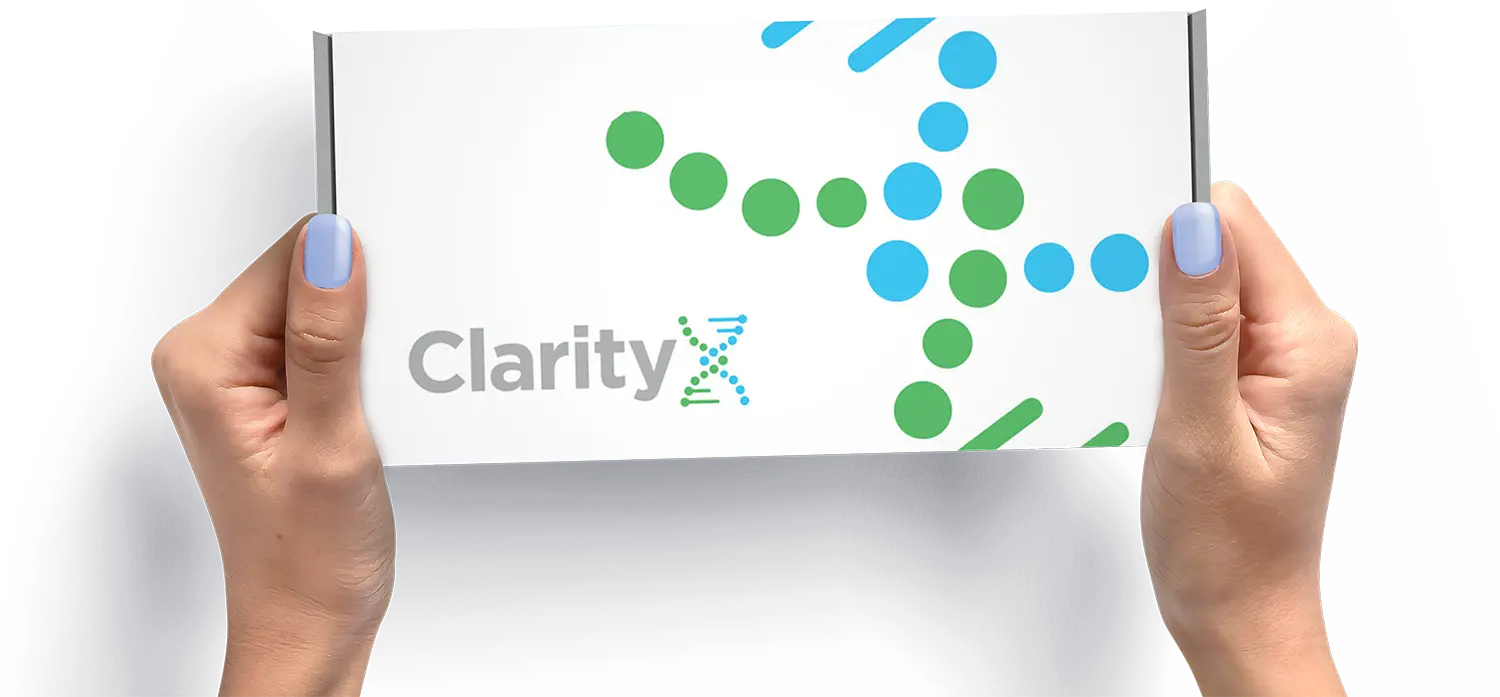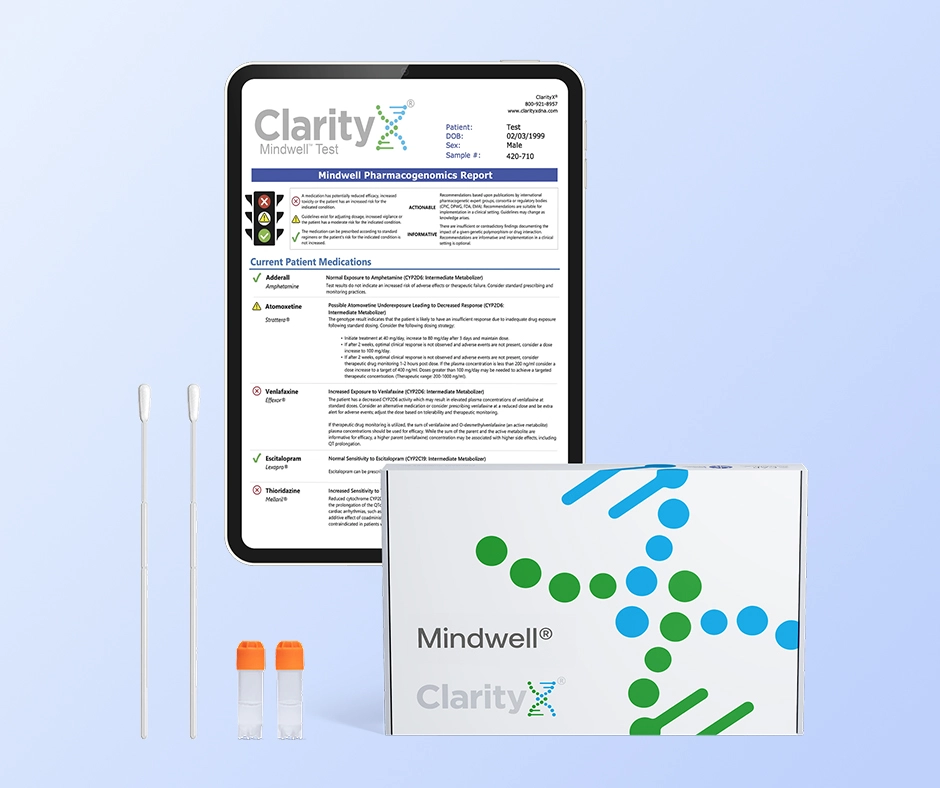Selecting the right psychiatric medication for any condition can be an arduous process, especially for those who have never done it before. When deciding to go on an antidepressant or a medication of any kind, most people typically accept that the drug their doctor prescribes is what is right for them. After all, the experts know best, right? While medical professionals have a wealth of knowledge about medical conditions and the human body, there is always room for improvement when it comes to how your body may react to a drug.
Recent advancements in science and technology have shed light on the many gaps that exist in choosing the right psychiatric medication for patients with depression. It used to be standard practice to abide by the trial and error method, but these days there’s a better way: pharmacogenetic testing for antidepressants. Nortriptyline and amitriptyline are two antidepressant medications that are commonly prescribed for individuals suffering from depression. While there are similarities between the two, the differences between nortriptyline vs amitriptyline and your body chemistry may cause doctors, pharmacists, and patients to choose one over the other. Genetic testing for medications like these acts as a valuable tool to help determine which antidepressant may be the most effective and the least disruptive as it pertains to negative side effects and drug interactions.
Nortriptyline Vs Amitriptyline
Before you choose nortriptyline vs amitriptyline, it’s important to understand the nuances between the two. Learning about the differences between these two antidepressants may help you make a more informed decision when speaking with your healthcare professional about treatment options for depression. Genetic testing for antidepressants may also help.
Nortriptyline Vs Amitriptyline: What are They?
Nortriptyline and amitriptyline fall into the drug classification group known as tricyclic antidepressants (TCAs). As an older class of antidepressants, TCAs date back to the 1950s. Tricyclic antidepressants work by blocking the reuptake of serotonin and norepinephrine, which are naturally occurring neurotransmitters (chemical messengers) that send signals between the brain and nerve cells.
Serotonin or 5-hydroxytryptamine is a monoamine neurotransmitter that helps regulate mood, anxiety, sleep habits, and happiness. Low levels of serotonin may indicate a higher risk of depression and/or anxiety. Norepinephrine is both a neurotransmitter and a hormone that helps regulate heart rate, blood pressure, blood sugar levels, and energy levels. It also impacts sleep, concentration, memory, and happiness.
Both nortriptyline and amitriptyline have been FDA-approved to help treat people with clinical depression. They may be specifically useful for individuals who experience persistent nerve pain that contributes to depression. In addition to being used for depression, both of these TCAs have off-label uses for other conditions including chronic pain in adults, neuropathic pain syndromes, and issues such as muscle pain, bladder pain syndrome, and migraines.
There are many similarities between nortriptyline and amitriptyline, including their side effects, how they work, efficacy, and dosage. Still, these two drugs are not the same and minor differences between the two may be significant enough for individuals to choose nortriptyline vs. amitriptyline or the alternative. We will cover more on nortriptyline vs. amitriptyline below to help you and your healthcare provider make as educated a decision as possible about the best psychiatric medication for you.
What is Nortriptyline?
The antidepressant medication nortriptyline is a prescription drug used for the treatment of clinical depression. Nortriptyline is available under two brand names: Pamelor® and Aventyl®, and is part of the group of medications known as tricyclic antidepressants. Nortriptyline is a secondary amine, which means it has 2 carbon atoms bonded to its nitrogen atom. The body converts amitriptyline (a tertiary amine) to nortriptyline to be used to balance the amount of serotonin and norepinephrine in the brain.
In addition to being used as a depression treatment option for individuals with nerve-related pain, nortriptyline may also be used as a medication for ADHD, nicotine dependence, bedwetting, shingles pain, and bladder disorders.1
What is Amitriptyline?
The antidepressant amitriptyline is another TCA used to treat clinical depression for people suffering from persistent nerve pain. Amitriptyline hydrochloride or amitriptyline was once available under the brand names Elavil, Endep, and Vanatrip, all of which have been discontinued by their manufacturers. The medication is still available in its generic form to help with depression, mood regulation, and treat nerve pain and insomnia.2 Amitriptyline is a tertiary amine, which means it has 3 carbon atoms bonded to its nitrogen atom. Similar to nortriptyline, it works on the central nervous system to help balance how serotonin and norepinephrine are both absorbed and utilized.
Nortriptyline vs Amitriptyline: Common Side Effects
Bringing a new medication into your system often comes with a risk of side effects. Not everyone experiences side effects with TCAs. The likelihood of having side effects with nortriptyline vs. amitriptyline varies based on individual body chemistry and makeup, weight, dosage, medical history, current medications you may be on, and many other factors. Genetic testing for depression may help reduce the chances of experiencing negative side effects with antidepressants. It is important to be aware of how any drug may impact your body prior to taking it. Learn more about the potential side effects of nortriptyline vs amitriptyline below.
Common Side Effects with Nortriptyline
Some people who take nortriptyline may experience the following side effects:
- Impaired coordination
- Disorientation
- Insomnia
- Agitation
- Restlessness
- Dry skin
- Changes in blood sugar levels
- Increased urgency to urinate
- Sensitivity to sunlight
- Tremors
In general, nortriptyline tends to result in fewer side effects when compared to amitriptyline and other tricyclic antidepressants
Common Side Effects with Amitriptyline
Individuals on amitriptyline may present a range of side effects, some of which may include:
- Drowsiness
- Headaches
- Unsteadiness
- Nightmares
- Changes in appetite
- Changes in weight
Shared Side Effects of Nortriptyline and Amitriptyline
There are also several shared side effects of both nortriptyline and amitriptyline. These include:
- Constipation
- Tiredness/drowsiness
- Urinary retention
- Excessive sweating
- Blurred vision
- Physical weakness
- Dry mouth
- Confusion
- Nausea and vomiting
- Sexual side effects include changes in sex drive, performance, and erectile dysfunction (ED)
Please note that this is not a complete list of side effects. Contact your healthcare provider if you experience severe side effects or have side effects with nortriptyline or amitriptyline that last longer than 2 weeks.
Nortriptyline vs Amitriptyline: Dosage & Forms
Your doctor will prescribe the dose of either nortriptyline or amitriptyline that they feel is best for you based on your medical history, symptoms, current condition, response to previous treatment methods, age, lab tests, other medications you may be taking, and several other factors. Regardless of whether you are taking nortriptyline vs amitriptyline, it is important to always take your medication exactly as prescribed.
Nortriptyline Dosage
Dosing nortriptyline is patient-specific. Do not take more or less than your prescribed amount or increase the frequency unless advised to do so by your doctor. Nortriptyline is available as a capsule and an oral liquid solution. The capsule comes in 10 mg, 25 mg, 50 mg, and 75 mg strengths. The oral solution comes in a 10mg/5mL strength.
The average recommended dose for adults with depression is 25 mg to be administered 3 to 4 times per day. It is not recommended to exceed 150 mg per day. The average recommended dose for teenagers with depression is 30-50 mg once per day, or that amount to be divided into several doses throughout the day.3 If taken once per day, most people take nortriptyline before bed. It is not recommended for children under the age of 18 years old to take nortriptyline.4
Amitriptyline Dosage
The proper dose of amitriptyline will differ based on each individual. Do not exceed or reduce the amount of this medication that your doctor has prescribed or increase/decrease the frequency unless advised to do so by a healthcare professional. Amitriptyline is available in tablet form in 10 mg, 25 mg, 50 mg, 75 mg, 100 mg, and 150 mg strengths. Most patients taking amitriptyline for depression start at 25-50 mg/day and may increase to 100-200 mg/day if directed by their physician. Doses for postherpetic neuralgia average between 65-100 mg/day; doses for migraine prophylaxis average between 10-25 mg but may go as high as 400 mg in certain cases; doses for eating disorders are typically around 150 mg/day.5 Most people take this medication once per day before bedtime.
Nortriptyline vs Amitriptyline: Drug Interactions
There are certain medications that should not be taken with nortriptyline and amitriptyline. These include buspirone (Buspar®), fentanyl (Abstral®, Duragesic®), lithium (Eskalith®, Lithobid®), tryptophan, St. John's wort supplement, and pain or migraine medicines including sumatriptan, tramadol, Frova, Maxalt, Relpax, and Zomig.6 Additionally, it is recommended that people on TCAS avoid eating grapefruit or drinking grapefruit juice, as doing so may increase the amount of the medication in your bloodstream.7
Drug Interactions for Nortriptyline vs Amitriptyline
Some medications, products, vitamins, and supplements may impact the effectiveness of nortriptyline, amitriptyline, and other TCAs. Avoid taking arbutamine, blood thinners (warfarin), thyroid supplements, and high blood pressure medication unless otherwise instructed by your doctor. It is also recommended that individuals planning to take nortriptyline stop taking MAO inhibitors at least two weeks before, during, and after going on this medication.
Nortriptyline vs Amitriptyline: How Long Does It Take to Start Working?
Just as with most antidepressants, tricyclic antidepressants typically take between 6 to 8 weeks before users may start to see significant signs of improvement in their depression. People who take nortriptyline vs amitriptyline may start to see positive effects on mood, sleep, and pain within the first several weeks, but substantial improvement will usually take longer. This is generally true for both SSRIs and TCAs.8 Please note that while neither nortriptyline nor amitriptyline is habit-forming, they may cause flu-like withdrawal symptoms if discontinued suddenly.
Nortriptyline vs Amitriptyline: Which One Should I Take?
The drugs nortriptyline and amitriptyline are similar in many ways, including their effectiveness, how they work, how well they work, and even dosage. Their similarities are due to the fact that they are both amines, which are chemical compounds that contain a nitrogen atom and a lone pair. Where they differ is in the type of amine; amitriptyline is a tertiary amine whereas Nortriptyline is a secondary amine.
The body converts amitriptyline to nortriptyline so it can balance neurotransmitters. This is the case for all secondary amines vs tertiary amines and is the reason that some people tolerate nortriptyline better than amitriptyline.9
For general depression, nortriptyline vs amitriptyline work about the same but one may be better suited than the other for off-label uses as they relate to conditions that could impact/worsen your depression. Overall, patients seem to find that they experience fewer side effects with nortriptyline than with amitriptyline and other tricyclic antidepressants. Additionally, nortriptyline is available in both capsule and liquid form, whereas amitriptyline comes in only tablet form. Conversely, taking nortriptyline vs amitriptyline may come with an increased risk of heart problems for people who have a history of cardiac conditions.
Nortriptyline vs Amitriptyline: Similarities and Differences
Pharmacogenomic (PGx) Testing for Antidepressants
It used to be the case that the only way to determine the best antidepressant for an individual was through trial and error. Now there’s a better way: Pharmacogenomic (PGx) testing reduces the guesswork by immediately identifying which drug may be the most suitable for a person based on their unique genetics. In addition to helping people decide between medications, it may also help patients and their physicians select the optimal dosages.
PGx testing works by examining the genetic variations in enzymes in the body that metabolize (i.e., either eliminate or activate) drugs. Testing will reveal how efficiently someone breaks down certain drugs, which could help indicate the best course of medication treatment for their needs.
ClarityX: DNA Testing for Medication
ClarityX analyzes DNA to give patients detailed reports about how they may react to certain drugs. We look for variations with the cytochrome 450 enzymes (which metabolizes over 70% of drugs), including the enzymes CYP2C19 and CYP2D6 which are responsible for how you may react to Nortriptyline and Amitriptyline. ClarityX offers two testing options with our pharmacogenetic testing:
- Mindwell test: This focuses on treatments for mental health conditions that include but are not limited to depression, anxiety, ADHD, OCD, and more.
- Max Rx test: This covers 31 therapeutic areas to test how an individual may respond to more than 265+ medications.
Both the Mindwell and Max Rx tests could help determine how you will respond to nortriptyline vs amitriptyline. This could help you and your healthcare provider make more informed decisions about your treatment plan. Click here to learn more.
1https://www.iodine.com/compare/elavil-vs-pamelor
2https://www.iodine.com/compare/elavil-vs-pamelor
3https://www.mayoclinic.org/drugs-supplements/nortriptyline-oral-route/proper-use/drg-20071998
5https://reference.medscape.com/drug/levate-amitriptyline-342936
6https://www.mayoclinic.org/drugs-supplements/nortriptyline-oral-route/proper-use/drg-20071998?p=1
7https://www.health.harvard.edu/staying-healthy/grapefruit-and-medication-a-cautionary-note
8https://pubmed.ncbi.nlm.nih.gov/10760555/
9https://www.ncbi.nlm.nih.gov/pmc/articles/PMC6135127/
10https://www.forhims.com/blog/nortriptyline-vs-amitriptyline





